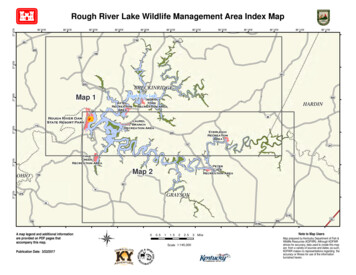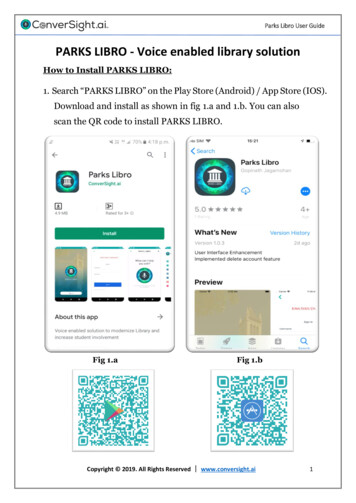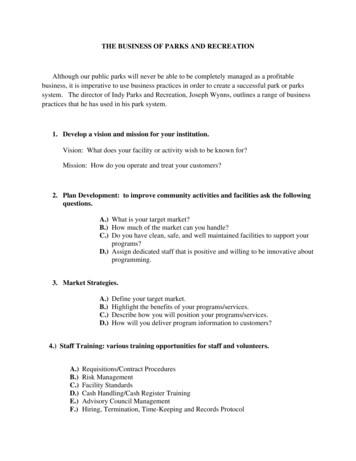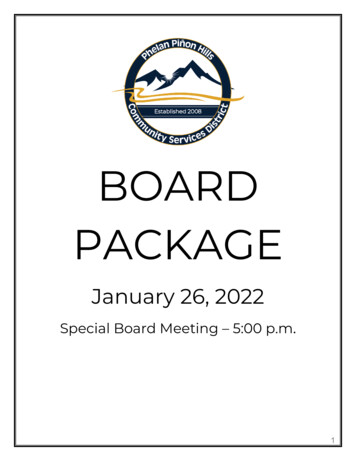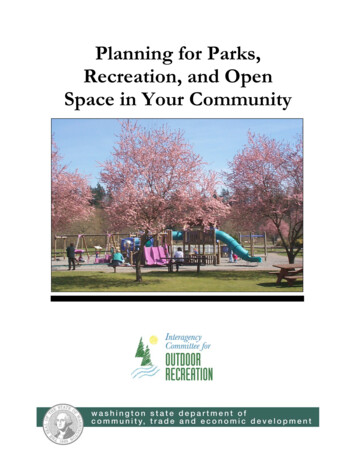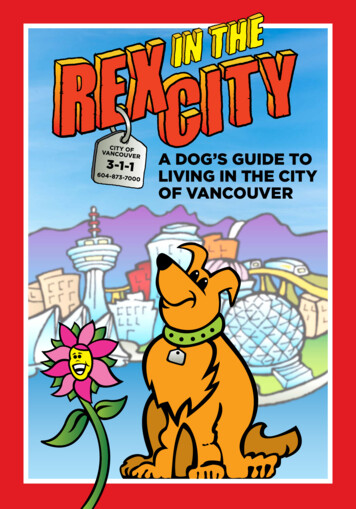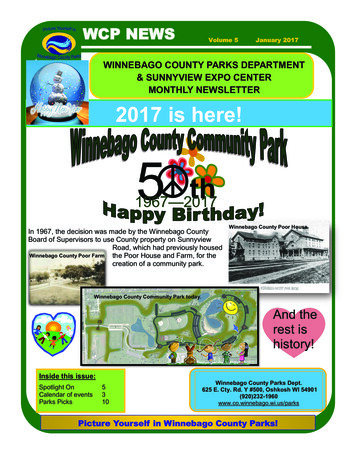
Transcription
Chapter 8Parks, Recreationand Open SpaceElement
CHAP TER 8: PARK S, RECRE AT ION AND OPEN SPACEC I T Y W I D EE L E M E N T S
C I T Y W I D EOverviewE L E M E N T SParks, Recreation andOpen Space800This Element addresses the future of parks, recreation, andopen space in Washington, DC. It recognizes the important role parksplay in recreation, aesthetics, health and wellness, neighborhood character,environmental quality, and resilience. The element also recognizes thatparks have the potential to bring people together across social, economic,and racial divides. It includes policies on related topics, such as recreationalfacility development, the use of private open space, the creation of trailsto better connect the District’s open spaces and neighborhoods, and thesupport of resilience through the restoration of natural systems. Finally,this element includes policies and actions that support the delivery ofequitable access, great spaces, and exceptional experiences. 800.1The critical parks, recreation, and open space issues facing Washington,DC are addressed in this element. These include: Coordinating and sharing stewardship between Washington, DCand the federal government on park and open space planning,design, and management to produce better outcomes for Districtresidents; Providing additional recreational land and facilities in areas of theDistrict that are currently underserved and in newly developing areas,and improving access; Maintaining, upgrading, and improving existing parks and recreationfacilities as key features of vibrant neighborhoods in Washington, DC; Increasing funding for capital improvements and operations throughpartnerships and creative strategies; Fostering community health so that residents can seek healthierlifestyles regardless of income, ability, or employment; Leveraging open space to support resilience, including floodmitigation, well-connected habitats on land and water, an increasedtree canopy, and strong ecosystems for wildlife; and Designing parks, trails, and recreational facilities to improve thesafety of staff and visitors. 800.2Washington, DC, is one of the few cities in the United States that wasoriginally planned and designed around the framework of a park system.The L’Enfant Plan featured broad swaths of open land to frame iconicbuildings and landmarks. Wide park-like boulevards were incorporated topreserve key views and vistas. 800.3Policies for the Park Service lands are contained in individual General Management Plans prepared by theNPS, and are also included in the Federal Elements of the Comprehensive Plan. There have also been severaljoint District/Federal park planning initiatives launched since the 1960s.1 Parks, Recreation,and Open Spacesin the DistrictSince the 2006 ComprehensivePlan, Washington, DC, hascontinued to enhance itsparks, recreational, and openspaces. The Department ofParks and Recreation (DPR)now manages more than 900acres of green space, 34 urbangardens and five partnerurban farms, 375 parks, 12dog parks, 95 playgrounds,135 athletic fields, 336 courts,76 recreation facilities, and 50aquatic facilities and features.In 2018, Washington, DC, wasranked the third fittest city onthe American Fitness Indexiand was ranked the fourthbest park city.ii 800.1a8Parks, Open Spaces,and Natural ResourcesThe Sustainable DC Planenvisions a District that hashigh-quality, well-connectedhabitats on land and water,and that provides strongcorridors and ecosystems forwildlife. Washington, DC,will conserve and managethese natural resources toenhance biodiversity, controlstormwater, reduce the urbanheat island effect, becomemore resilient to changingclimate conditions, andbuild people’s connectionsto, understanding of, andappreciation for nature. 800.2aPARK S, RECRE AT ION, AND OPEN SPACE8-1
C I T Y W I D EE L E M E N T SThe 1901 McMillan Plan continued this legacy, using open space to accomplishsocial as well as aesthetic goals. The McMillan Plan made a conscious effort toextend the park system beyond the monumental core, connect existing parkswith scenic roadways, and provide for the recreation and health of a growingpopulation. The National Mall and Rock Creek Park that we know today areamong that plan’s legacies. Many of the early plans prepared by the NationalCapital Parks and Planning Commission (NCPC) placed a similar emphasis onimproving the District’s open spaces and parkways. Many of the District’s parksand recreational facilities established during this time were racially segregatedand developed to different standards. 800.4These historic plans have resulted in more than 7,800 acres of permanentopen space and parkland in Washington, DC, and one of the highest ratios ofpark acreage per resident in the country. Nonetheless, when Washington, DCachieved Home Rule and set about developing its first Comprehensive Plan, aParks, Recreation, and Open Space Element was not included. This responsibilitywas left to the federal government. Today, 74 percent of Washington, DC’sparkland is still managed by the National Park Service (NPS) and is not underthe District’s jurisdiction.iii The other 26 percent includes 10 percent managed bythe District’s Department of General Services (DGS) and DPR, and 16 percentmanaged by other entities, including DC Public Schools (DCPS). 800.58Including a chapter on parks, recreation, and open space in the District elementsof the Comprehensive Plan is important for a number of reasons: First, the District itself owns approximately 950 acres of parkland, andthere is a need for a coordinated set of policies for its management. Second, access to quality parks and open space is a top priority forDistrict residents—regardless of who owns the land. The fact that most ofthe District’s open space is federally controlled suggests that joint policyplanning for these assets is essential. Third, Washington, DC is changing, which means recreational needsalso are changing. Policies are needed to make sure that new park andrecreational opportunities are provided and existing parks are improvedto meet the needs of a changing and expanding population. Fourth, parks are essential to many of the goals expressed elsewhere inthe Comprehensive Plan, including sustainability, resilience, improvedpublic health, racial equity, and inclusion. 800.6Parks are part of the foundation of what makes Washington, DC, a great place tolive. They are where friends are met, and where people walk, play, and exercise.They contribute to personal wellness and the quality of the environment. Theykeep neighborhoods vibrant, enhance property values, and foster civic bonds.The policies in this element are aimed at sustaining parks as great public spaceswhile providing more equitable access to parks across the District. Achievingthese outcomes requires different strategies for different neighborhoods. Wheninvesting in parks, District government and other stakeholders should consider8-2THE COMPREHENSI VE PL AN FOR THE NAT IONAL C AP I TAL DI S TR IC T ELEMENTSEFFECT IVE FROM AUGUST 21, 2021
C I T Y W I D EE L E M E N T Sa fair distribution, amount, and quality of parkland and facilities across theDistrict—as well as other social factors, such as income and age, that may shapelocalized decisions in programming and design. 800.7The Comprehensive Plan is supplemented by a more detailed set of planningdocuments for parks and recreation that address these issues, including masterplans and a collaboration with the federal government, titled CapitalSpace.These companion plans establish bold visions for advancing the District’s parksand recreation goals, starting with an overarching master plan for parks (see textbox entitled Parks Master Plan). In addition, the Sustainable DC Plan, completedin 2012 and updated in 2018, provides further guidance. 800.8The overarching goalfor parks, recreation,and open space is topreserve and enhanceparks and open spaceswithin Washington,DC to meet active andpassive recreationalParks, Recreation,and Open Space Goalneeds through universalaccess, promote healthand wellness, improve801The overarching goal for parks, recreation, and open space is to preserveand enhance parks and open spaces within Washington, DC to meet activeand passive recreational needs through universal access, promote healthand wellness, improve environmental quality, enhance the identity andcharacter of District neighborhoods, and provide visual beauty in all parts ofWashington, DC. 801.1environmental quality,8enhance the identityand character ofDistrict neighborhoods,and provide visualbeauty in all parts ofPolicies and ActionsWashington, DC.PROS-1 Park Planning and Land Management802This section of the element focuses on parks that are owned and operated bythe District. Policies also express the District’s perspectives on the federallyowned parks that serve residents. 802.1The District manages 375 parks and open spaces, comprising approximately950 acres. More than two-thirds of these properties are small open spacetriangles formed by the intersection of diagonal avenues and the Districtstreet grid. The remainder includes 17 regional parks, 86 neighborhoodand community parks, 51 pocket parks, and eight natural areas. Figure 8.1provides an overview of DPR-managed amenities. 802.2For planning purposes, park activities are usually divided into two categories:active recreation and passive recreation. Active recreation is associated withsports or play activities and requires facilities such as playgrounds, ballfields, tennis courts, and swimming pools. Passive recreation emphasizes theopen space aspect of a park or waterway and includes activities like hiking,picnicking, and kayaking. In Washington, the presence of District-ownedparks and national parks provides a unique blend of active and passiverecreational opportunities. 802.3PARK S, RECRE AT ION, AND OPEN SPACE8-3
C I T Y W I D EThe Parks Master PlanE L E M E N T S803In 2006, DPR drafted its firstComprehensive Master Plan sinceits establishment in 1942. Buildingon this earlier work, DPR and theDC Office of Planning completedthe Parks and Recreation MasterPlan in 2014 (the Parks MasterPlan). 803.1The Parks Master Plan evaluates the existing park system, defines community priorities, and identifies a potentialprogram of investments to make the park system more equitable and responsive to local needs. It is basedon a detailed evaluation of conditions at all parks, recreation centers, and outdoor facilities; a comprehensiveassessment of recreation programs; and an evaluation of service gaps based on public input, industry bestpractices, and objective standards. 803.28The District is now at a stage where a new District-wide parks planning effort is needed to identify and prioritizethe next round of major capital investments. Population and development pressures, changing recreational trends,and the opportunity, through recently passed federal legislation, to explore cooperative local management offederal parkland, all present new opportunities and realities that the District faces in meeting the recreationalneeds of it residents. In addition, there is a need to create a District-wide plan for funding and maintainingexisting, as well as new, recreation centers and park sites. For all of these reasons, DPR will begin a new parksmaster planning effort in 2020 that builds on the work of the 2014 plan as well as the 2010 CapitalSpace plan. 803.3The Parks Master Plan addresses seven key elements of the park system: Parkland; Recreation centers; Aquatics facilities; Outdoor facilities; Programs; Bikeways and trails; and Environmental lands and natural areas. 803.4For each element, the Parks Master Plan provides target benchmarks forservice delivery. Specific outcomes of the Parks Master Plan include: Comprehensive information on the recreational needs ofDistrict residents; Projections of expected future needs, based on growth and demographics; Information on customer usage and satisfaction; Identification of current and potential shortfalls; and Strategies for overcoming shortfalls, including land acquisition andprogramming changes. 803.58-4THE COMPREHENSI VE PL AN FOR THE NAT IONAL C AP I TAL DI S TR IC T ELEMENTSEFFECT IVE FROM AUGUST 21, 2021CAPRAAccreditationIn 2014, DPRbecameaccredited bythe Commissionfor Accreditationof Park andRecreationAgencies (CAPRA).This designation“recognizes andrequires standardsof excellence inthe parks andrecreation field.”803.5a
C I T Y W I D EE L E M E N T SPROS-1.1 Developing a ParkClassification System804Most large cities in the United States have adopted classificationsystems to guide the management of their parks and open spaces. Infact, the National Recreation and Park Association (NRPA) definespark classification as the basic element of the planning function.Classification provides a basis for deciding which activities andfacilities are appropriate within each park. It also provides a means ofanalyzing where service gaps exist and where acquisitions and capitalimprovements may be required. 804.1Until 2006, the District’s parks were loosely classified as large parks,neighborhood parks, recreation center grounds, and triangles. Thesecategories are not consistent with national standards, making itdifficult to evaluate the adequacy of parks or to compare the Districtwith peer cities. 804.2The 2006 Parks Master Plan recommended a new classificationsystem to improve customer service and park management.Under this system, DPR would develop a park classificationsystem with clear definitions of each classification based on areview of industry standards and best practices. This wouldallow the agency to develop more specific level of servicestandards based on each classification. 804.3“Redesign the parks to includesafe play areas, gardens andseparate exercise areas as well asseating areas. Look in all areasof the city for this opportunity.”Suggestion from a Participant ata Comprehensive Plan Meeting8Figure 8.1:DPR-Managed Parks,Recreation, and OpenSpace Amenities 804.5Figure 8.2 summarizes a sample park classification system. Map8.1 shows the location of District-owned parks. The small openspaces are not shown due to the map scale and their small size.804.4An important consideration in classifying Washington, DC’sparks is the role that federal lands play in the overall parksystem (noted in Policy PROS 1.1.2). In many parts of theDistrict, federal land plays a crucial role in meeting park,recreation, and open space needs. Some of Washington, DC’sparks are part of a contiguous system of parks and open spaces,with different areas under different ownership and management.Such systems need to be cohesively planned and managed, andnot treated as individual isolated neighborhood or communityparks. 804.8Policy PROS-1.1.1: Park Classification830 acres of green space375 parks200 outdoor basketball courts160 tennis courts119 athletic and ball fields94 playgrounds76 recreation centers35 gyms34 community gardens31 aquatic pools25 spray parks23 fitness centers13 dog parks7 wellness centers7 boxing ringsAdopt and maintain a classification system to guide the futureuse of District parks. Figure 8.2 provides the framework for thissystem. Follow general management prescriptions for each typeof park, as defined by the official Parks Master Plan. 804.95 urban farms1 outdoor amphitheater1 skate park(Source: DPR,2017)PARK S, RECRE AT ION, AND OPEN SPACE8-5
C I T Y W I D EE L E M E N T SFigure 8.2Sample Park Classification System804.6Park TypeDescriptionTypical UsesService Area*Small ParkPocket parks or triangles. Range fromlandscaped “islands” to places for socializing,playing chess, etc.Benches, seating areas, public art,landscaping¼-mile radiusNeighborhoodProvide informal, centrally located setting forneighborhood-based recreational amenities,possibly including recreation centersPlaygrounds, tot lots, basketball courts,open lawn areas for unstructured play,seating and picnic areas, community½-mile radiusgardens, and interpretive or educationalexhibitsCommunityLarger parks with more structured recreationalopportunities, including recreation centerbuildings with a range of DPR programsActive play-oriented outdoor facilities,such as ball fields, athletic courts,playgrounds, indoor and outdoor swimfacilities, natural amenities such as trails,natural areas, and picnic groundsRegionalLarge multiuse parks that draw users Districtwide or from beyond adjacent neighborhoodsVery large areas of open space,recreation centers, lighted athletic fields,District-widegroup picnic areas, hiking, multipleactivity areasNaturalResourceAreasParks established to conserve open space andsensitive natural resources or heritage assets. Ifadjoined by open, level areas, then recreationalfields and play areas may be appropriateLow-impact, passive activities, such ashiking and environmental educationN/A—notdemand drivenSportsComplexesProgrammed athletic fields and multiuseindoor complexes, custom designed for specificprogrammed usesTrack and field, natatorium, softball,soccer, tennis, basketball, volleyball,racquetball, football, boxing, martialartsDistrict-wideSpecial UseParks dedicated to a single use, such as a zoo oramphitheater. Accommodate highly organizedactivities and provide economic as well associal and physical benefits. May have highlyspecialized management requirementsGolf courses, aquatic or spray parks,sculpture parks, dog parks, arboretums,historic homes, amphitheaters, skateDistrict-wideparks, climbing centers, therapeuticfacilitiesSchool ParksPublic land on school property, developedwith playgrounds and open fields, designedfor student activities but also available forcommunity useRunning tracks, playgrounds, athleticfields, basketball courts½-mile to twomile radiusHard or soft paved paths providing linkageswithin or between parks, facilitating access andexplorationPaved or dirt trails, boardwalks,promenades½ to ¼ mile toaccess point8**Trails andBikeways** Some parks are nationally significant and serve an area larger than Washington, DC8-6THE COMPREHENSI VE PL AN FOR THE NAT IONAL C AP I TAL DI S TR IC T ELEMENTSEFFECT IVE FROM AUGUST 21, 2021One- totwo-mileradius, withconnectionsto bike andpedestriantrail networks
C I T Y W I D EE L E M E N T SMap 8.1Location of District Parks804.78(Source: DC Office of Planning, 2018 )PARK S, RECRE AT ION, AND OPEN SPACE8-7
C I T Y W I D EE L E M E N T SPolicy PROS-1.1.2: Consideration of Federal ParklandNew ParklandA 2014 DPR study estimatedthat 180 acres of newparkland will be needed tomeet demands associatedwith increased populationover the next 15-20 years.804.15aWork with federal agencies to evaluate the role that federal lands play inmeeting the recreational needs of District residents, particularly for regionalparks and sports complexes. Because these properties are used by residents,they should be considered when identifying underserved areas and assessingthe need for local park improvements. 804.10Policy PROS-1.1.3: Park DiversityProvide a diverse range of recreational experiences in parks withinWashington, DC, including a balance between passive and activerecreational uses, and a mix of local-serving, region-serving, and nationalrecreational uses. 804.11Action PROS-1.1.A: Park ClassificationComplete the classification of each of the District’s 375 properties usingFigure 8.1. Identify suggested (advisory only) classifications for federal parksas part of this process. 804.128Action PROS-1.1.B: Parks Master PlanImplement the Parks Master Plan for the District of Columbia ParksSystem. Update the plan at least once every five years or as needed to reflectchanging conditions and needs. Use the Parks Master Plan as the basis forthe annual Capital Improvement Program request for park and recreationalfacilities. 804.13Action PROS-1.1.C: Master Plans for Individual ParksPrepare master plans for large individual parks (such as regional parks) priorto major capital improvements as funding allows and use these plans toguide capital improvement and implementation processes. 804.14Action PROS-1.1.D: Quality of Existing Park SpacesDevelop an enhanced maintenance and improvement schedule to upgradethe quality of passive and active parklands and outdoor facilities, to makethe most of existing District parks. 804.15PROS-1.2 Closing the Gaps 805At first glance, Washington, DC appears to have a more than adequatesupply of parkland. There are 12.6 acres of parks per 1,000 residents,compared to 7.9 acres per 1,000 in Baltimore, 6.9 acres per 1,000 inPhiladelphia, and 7.7 acres per 1,000 in Boston.iv However, most of theDistrict’s parkland consists of passive federally owned natural resourceareas. Neighborhood and community parkland is much more limited andamounts to less than one acre per 1,000 residents in many parts of theDistrict. By contrast, suburban communities typically set standards of fouror five acres of active parkland per 1,000 residents. 805.18-8THE COMPREHENSI VE PL AN FOR THE NAT IONAL C AP I TAL DI S TR IC T ELEMENTSEFFECT IVE FROM AUGUST 21, 2021
C I T Y W I D EE L E M E N T SEven neighborhoods with abundant parkland may lack access to recreationalamenities and facilities. Other neighborhoods have parks that are toosmall to meet local needs, such as relief from the impacts of increasingtemperatures. For example, a lack of open space and accompanyingvegetation can result in heat islands that reduce local health quality. Manyof these neighborhoods include areas where significant growth is takingplace, and the increased volume strains the ability of the facilities to meetneighborhood needs. Improved access to parks is also needed throughimprovements to bus service, enhanced pedestrian and bicycle routes,and better security. Figure 8.3 presents recommended benchmarks fordelivery of parks and recreation services. 805.2Recreational needs are also a function of demographics and density. Theneed for parks may be more critical in some areas of the District due to: Limited mobility due to low rates of auto ownership; Larger numbers of children, older adults, and/or populations withchronic disease;8 Larger numbers of apartment dwellers living in housing withoutusable open space; Denser development patterns without the aesthetic amenities, heatisland mitigation, and stormwater management benefits afforded byopen space; and Larger concentrations of youth who may benefit from programmedrecreational activities. 805.3These factors suggest that special attention be given to increasing usableopen space in the District’s densest neighborhoods, even where parks alreadyexist. Special attention must be given to improving access, park capacity, andacreage for communities where access or acreage is poor. 805.4Improved data collection will allow the District and its partners to plan fora healthier and more active community. More robust data will help improvefacilities usage and participation measurement, master planning, capitalinvestment, and programming decisions. The implementation of systemsto track the work of DPR—such as maps to show progress in closing level ofservice gaps—and visitor data to observe trends in program participation areimportant for prioritizing projects and improving community outcomes. 805.5Policy PROS-1.2.1: Closing the GapsAchieve a better distribution of high-quality parks in all neighborhoods ofWashington, DC. Provide access to the natural environment or quality greenPARK S, RECRE AT ION, AND OPEN SPACE8-9
C I T Y W I D EE L E M E N T Sspace within a 10-minute walk of all residents. This will require a priority toimprove or expand parks in: More densely populated neighborhoods with limited open space; Areas that are more than a half mile from a neighborhood orcommunity park (or a federal park that serves an equivalentfunction);Figure 8.3Benchmarks for Delivery of Parkand Recreation Services805.68VariableBenchmarkAccess to “Meaningful” PublicOpen Space (improved parkslarger than 1/3 acre)Within one-half mile of all residents 4 acres per 1,000 residents in eachneighborhood clusterPublic Open Space Land Area 2 acres per 1,000 residents in greaterDowntown DC (e.g., the CentralEmployment Area)Access to Recreation CentersWithin one mile of all residents Indoor pool within two miles of allresidentsAccess to Aquatics Facilities Outdoor pool within 1.5 miles of allresidents Splash pad within one mile of allresidents8-10Access to Outdoor Facilities80 percent of all DC residents will ratetheir access to outdoor facilities as good orexcellentProgram Options25 percent of all DC residents willparticipate in a DPR program, and 90percent will rate their experience as beinggood or excellentTHE COMPREHENSI VE PL AN FOR THE NAT IONAL C AP I TAL DI S TR IC T ELEMENTSEFFECT IVE FROM AUGUST 21, 2021
C I T Y W I D EE L E M E N T S Areas where substantial new housing growth is expected, based onthe forecasts of the Comprehensive Plan; Areas where the existing recreation centers and parks are in poorcondition; and Areas where social and economic conditions compel a greaterinvestment in parks to improve health, public safety, and communitywell-being. 805.7Policy PROS-1.2.2: Improving AccessibilityImprove accessibility to and within the major park and open space areasthrough pedestrian safety and street crossing improvements, wayfindingsignage, bike lanes and storage areas, perimeter multiuse trails within selectparks, and adjustments to bus routes where appropriate. All parks should beaccessible by foot, and most should be accessible by bicycle. Seek to provideaccess within parks for all ages and abilities consistent with park use andrecognize that paved trails are accessible to wheelchair users, whereas dirt,cinder, and wood chip trails can present challenges for these users. 805.88Policy PROS-1.2.3: Responding to Community ChangeUpdate and improve existing parks in response to changing demographics,cultural norms, and community needs and preferences. Parks should reflectthe identity and needs of the communities they serve. Further, the parks andrecreation system should evolve to offer a variety of facilities located withina reasonable distance of each resident and provide a range of programs inspaces designed to flex as residents’ needs and interests change. 805.9Action PROS-1.2.A: Bus RoutingConsult with the Washington Metropolitan Area Transit Authority(WMATA) and the DC Circulator to identify locations where additional busstops are needed to serve neighborhood and community parks, particularlythose with recreation centers. 805.10Action PROS-1.2.B: Public InvolvementConsult with Advisory Neighborhood Commissions (ANCs) and localcommunity groups on park planning and development to understand andbetter address resident priorities. 805.11Action PROS-1.2.C: Park Spaces on District PropertiesEncourage shared-use agreements for green spaces owned by Districtgovernment and DCPS so that these areas are available and accessible toresidents for recreational purposes. 805.12PARK S, RECRE AT ION, AND OPEN SPACE8-11
C I T Y W I D EE L E M E N T SAction PROS-1.2.D: Temporary Activation of Underutilized SpacesIdentify underutilized spaces that can be programmed on a seasonal andtemporary basis to advance public life. Focus on commercial corridors wherepark space is scarce. Consult with ANCs, local community groups, and localbusinesses to identify locations where on-street parking spaces, empty lots, orparking lots could be seasonally repurposed for outdoor recreational use. 805.13Action PROS-1.2.E: Open Space PlanEvaluate the need for a District-wide open space plan focusing on improvingphysical access to green space and the rivers. 805.14Action PROS-1.2.F: Promoting AccessPromote access to biking and swimming facilities and programs, with anemphasis on underserved and underrepresented groups. Explore opportunitiesfor roving park programming to serve residents in their communities. 805.158PROS-1.3 Preserving the Value of Parkland 806A park often reflects a neighborhood’s vitality and character. However, toooften, District parks have not been treated as the resource for revitalizationand community empowerment that they should be. Some suffer fromdeferred maintenance, illegal dumping, and crime. Others face challengesaccommodating competing needs within limited space. Previous planshave created hundreds of small pockets of green space, contributing to theuniqueness of the District’s character. Yet these spaces often pose a challengein terms of programming and maintenance. In addition, the parks are notmanaged by a single government but by multiple entities. Collaboration andcoordination are both necessary and often complex. 806.1Washington, DC’s parks should be viewed as limited and precious resources,no less valuable than the neighborhoods they serve. But the purpose of parkmanagement should not be solely to preserve open space. Parks meet therecreation, education, and social needs of District residents. The tree canopyand green infrastructure parks provide can improve community resilienceand sustainability through such activities as stormwater management, energyconservation, and carbon sequestration. They can support urban agriculturein areas with limited access to fresh produce. They can generate and supporteconomic and social benefits, such as youth employment, business attraction,cultural activities, and community gathering space. The District should striveto realize these multiple and diverse benefits in the design of its parks and otherpublic spaces. 806.2Small open spaces (those less than one acre in size) are a significant untappedresource that can enhance the District’s neighborhoods, connect residents to theircommunity through green networks, provide additional green space, and create asense of place. There are 1,149 of these spaces in the District. They are controlledby multiple entities of the District government: DPR, DGS, and the District8-12THE COMP
District—as well as other social factors, such as income and age, that may shape localized decisions in programming and design. 800.7 The Comprehensive Plan is supplemented by a more detailed set of planning documents for parks and recreation tha


